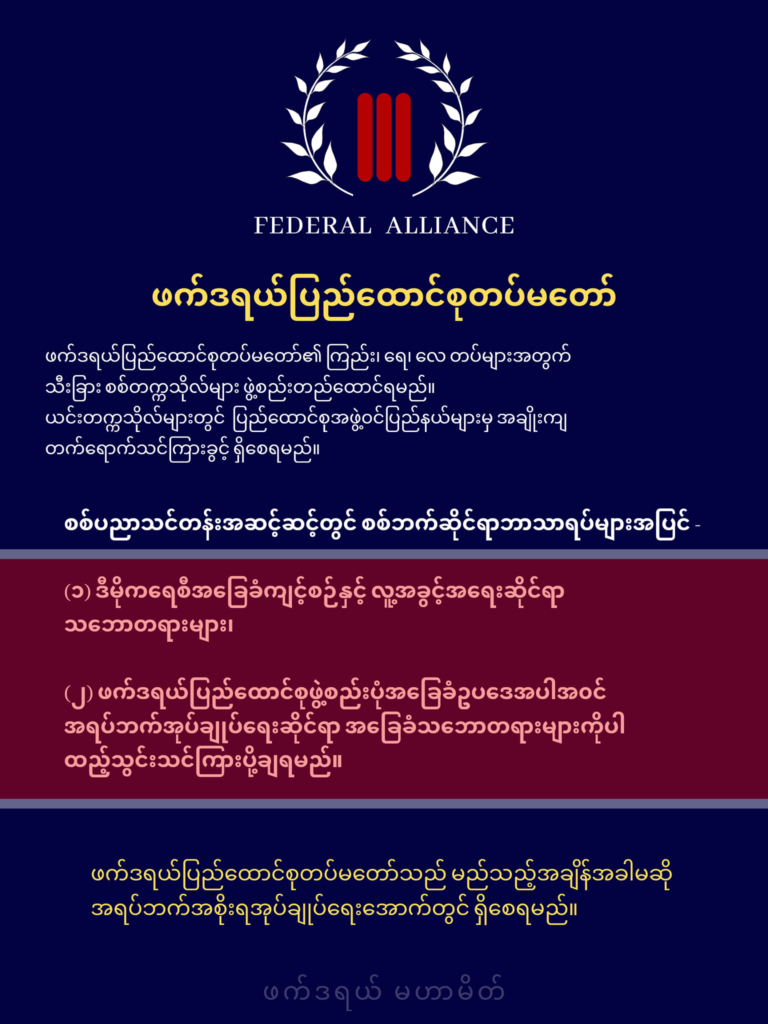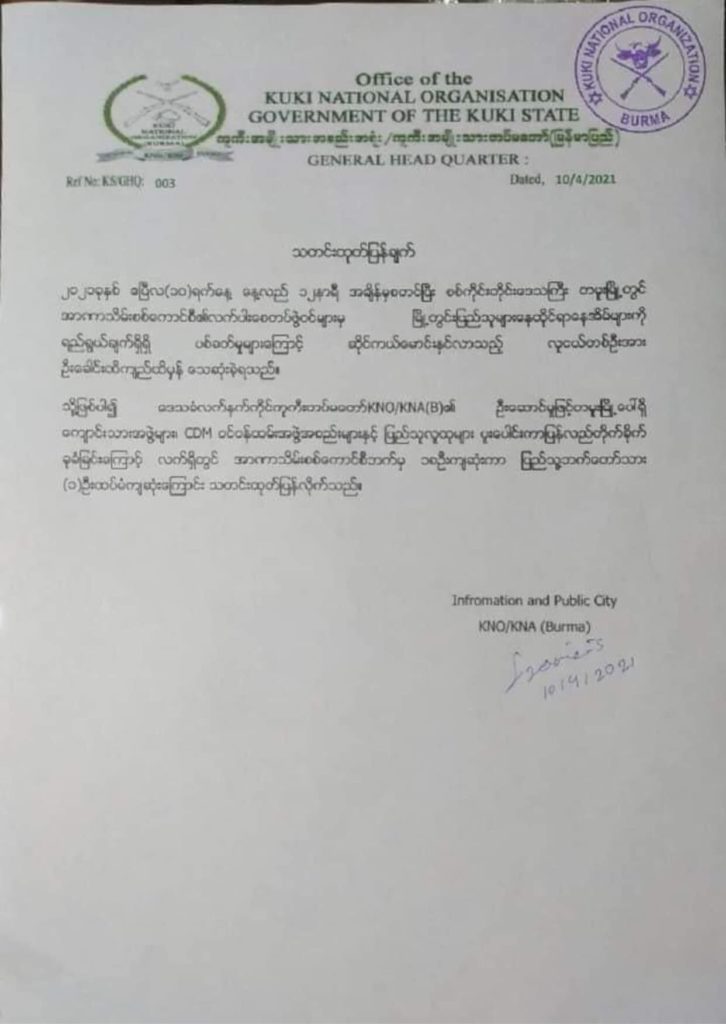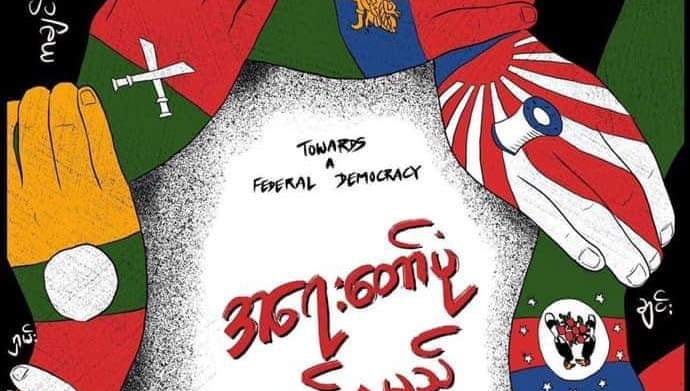Following the February 1 military coup overthrowing the elected National League for Democracy (NLD)-led government, the anti-military junta movement rallies have made use of a lot of slogans but the most outstanding ones have been built around the issues of anti-coup, support of civil disobedience movement (CDM), restoration of elected government, call for UN help or responsibility to protect (R2P), support for Committee Representing Pyidaungsu Hluttaw (CRPH) or Committee Representing Union Parliament and formation of the Federal Union Army (FUA), among others.

The call for formation of FUA has become even louder as the hope for R2P fade away hampered by the veto powers of Russia and China that makes the United Nations Security Council (UNSC) impotent because of Cold-War-like rivalry prevailing at the world’s decision-making body.
Actually, an ideal sequence for ethnic-democratic camp cooperation will be the abolition of military-drafted 2008 Constitution; new Federal Union Constitution acceptable to all stakeholders; formation of the national unity government (NUG); and establishment of a FUA.
Now, let us see at which stage we are in and how far have we have gained momentum to realize formation of a FUA so that the parallel government of the people, geared to be form with CRPH, CDM, civil society rally leaders, ethnic armed organizations (EAOs) and political parties, will be vested with enforcement capability appropriate with the features of a governing body with legitimacy.
The CRPH has completed its first step of nullifying the 2008 Constitution but the second stage of drafting a new constitution is still at the deliberation phase, which involved drafting constitutional guidelines and transitional period administration.
Accordingly, the drafting of Federal Union Constitution may take sometimes but the CRPH said the NUG would be formed in a matter of days. This means the government will come first and the constitution will come later.
Thus, the desired formation of FUA will certainly have to wait even though the situation is demanding to move more speedily and rapidly.
Let us look at the development on the ground to see if there are possibilities to fulfill such a task.
Present Situation
The Kachin Independence Organization/Army (KIO/KIA) and Karen National Union/Karen National Liberation Army (KNU/KNLA) have been heightening their attacks on the military or Myanmar/Burma Army positions in Kachin State, northern Shan State, and Karen State, since the beginning of the mass uprising on the first week of February.

The Three Brotherhood Alliance, which includes Arakan Army (AA), Myanmar National Democratic Alliance Army (MNDAA) or Kokang and Ta’ang National Liberation Army (TNLA) issued statement on March 30, demanding that Burma Army stopped killing civilians and addressed political solution to resolve the problems or it would have to side with the people.
To show that it meant business, on April 10, it started attacking the junta’s police station in Nawng Mawn, Lashio Township, northern Shan State, killing 14 policemen, wounding 7, with 2 missing, indicating that it has sided with the people’s uprising, now dubbed as “Spring Revolution”.
This means, the whole Northern Alliance – Burma (NA-B), which is the military alliance made up of AA, KIA, MNDAA and TNLA, is against the Burma Army or coup-maker junta regime.
The political alliance of Federal Political Negotiation and Consultative Committee (FPNCC) has seven member, made up of the NA-B and United Wa State Army (UWSA), National Democratic Alliance Army (NDAA) or Mongla, and Shan State Progress Party (SSPP), which are not yet committed to either side of the spectrum.
Meanwhile, the junta is trying to woo the three not to join the EAOs that are against its rule but the outcome is unclear at the moment.
The position of the Karenni National Progressive Party (KNPP) regarding the FUA is not clear, although its Vice-Chairman Khu Oo Reh said conversations between EAOs about forming a united front had been positive, the differences between groups had been “going on for 70 years”, according to Chiangrai Times of April 2.
Strength Comparison
Looking at the troop count the EAOs strength is estimated between 75,000 to 78,000 according to Anthony Davis, who is an analyst with the Jane’s Defence Weekly. But if one counts the reserves and local defense forces, it may amount to 100,000, according to keen observers.
The Myanmar Army is said to field some 400,000 soldiers but it may not be probably more than 350,000 as Anthony Davis has estimated. Some Burma experts pointed out that the real count may even be less as the battalion strength has dwindled dramatically from 750 in 1988, 200-300 in 2006, and recently to be around 100, according to East Asia Forum and various other sources.
“These estimates seem to be based on persistent reports of desertions, the difficulty of attracting new recruits, and the large number of child soldiers in the ranks,” wrote East Asia Forum in September 2010.
The situation at present is basically the same and thus, the Burma Army real strength may be just around 250,000 estimated the experts.
The air power of the Burma Army are largely “Russian Mi-35 helicopter gunships, new Russian Yak-130 ground attack aircraft, older Chinese ground attack jets which date from the early 1990s, and modern Chinese JF-17 [fighter] jets,” including artillery in the form of 105-mm and 122-mm cannons and multiple-barrel rocket launchers, according to Anthony Davis.
These weaponry were used against the AA in Arakan State and would probably be used against the NA-B and KNU/KNLA.
In comparison, the EAOs are armed with assault rifles, rocket launchers, and mortars in some cases and they don’t have significant firepower in terms of artillery. They also have no air power and some 107-mm surface-to-surface rockets which are useful for firing on large targets are about the heaviest weaponry they have in store, said Antony Davis.
Battle Scenarios
Given the facts available the ensuing armed conflict between the EAOs and the Burma Army on the ground may be fighting without coordination and cooperation among the former, and also without central joint-military command coordination.

Thus the KIA in Kachin State, the Three Brotherhood Alliance (AA, MNDAA and TNLA) in northern Shan State, and KNU/KNLA in Karen State are combating the Burma Army separately, according to the available reports.
Meanwhile, the civilian-based resistance, notably in Sagaing Region emerged from among the population to resist the Burma Army with home made guns and significantly in cooperation with Kukki National Organization (KNO) very recently, where a dozen or so junta’s soldiers were reportedly being killed.
On April 10, at least 18 members of Myanmar’s security forces were killed by activists in the afternoon after a civilian was shot in Tamu, Sagaing Region, on the Indian border. The KNO armed group issued a statement on that night, saying some 18 soldiers were killed in action by residents, protesters and KNO troops, according to The Irrawaddy report of April 11.
The KNO armed wing Kuki National Army (KNA) was founded on 24 February 1988 with the goal of creating a separate state administered by the Kuki people in India and Myanmar (Burma). From its formation to 2013, the KNA was involved in 20 armed confrontations with the Burma Army. It has about 2000 soldiers and is allied to the KIA, according to Wikipedia.
Reportedly, youths are flocking to EAO areas to learn how to fight as many are convinced that the Burma Army must be countered with force rather than just CDM, which isn’t enough.
But regarding the problematic of forming a FUA, what Min Ko Naing said recently in the interview with RFA is worth considering.
He said: “As we are establishing a federal union, the forces we employ should be federal army forces. How will we get there? We should take several steps. We don’t want that to take a long time. But we cannot skip the necessary steps. We should be quick and, at the same time, should meet certain standards. That’s why these young people should travel to the safe zones I have mentioned and they should join training programs. I think you know what kind of training I am talking about. They need to join hands with ethnic armed groups in these free zones. I cannot lay out the route to get to these safe zones on the map of Myanmar. They should check out what is the closest zone in your area and decide how to get there by themselves. Speaking from my experience, what we have learned about these places in prison is not very reliable because there are many informers among the detainees. We know the price to pay is high because we want to see enormous changes. So I want to reiterate that the processes of forming a federal army will not be lengthy, but we cannot skip the necessary steps.”
Perspectives
There is no doubt among the ethnic-democratic camp that FUA is a crucial and necessary cornerstone to replace the Burma/Myanmar Army or Tatmadaw as an institution. The institution is becoming so rotten to the core. As it has been built on Bamar supremacy and racist doctrine serving only the top brass and treating the people as inferior or subordinate underlings, the people by and large are convinced that this cannot be accepted anymore and have to be uprooted, once and for all.
But as Min Ko Naing said there are necessary steps to be taken, which in this case is to solicit the understanding of the EAOs and enlisting them, if not all at once, with the like-minded organizations to begin with. However, the fully fledged integration into the FUA will only be feasible after the Federal Union Constitution is in place.
At the moment, fighting separately even in loosely organized coordination and cooperation will serve the purpose, as the enemy capability will be stressed that will translate into the advantage of the ethnic-democratic camp. Beside, this will be able to overcome the junta’s divide-and-rule strategy which it has used successfully in the past, when combating the EAOs.
Meanwhile, the population in heartland Burma will have to form its resistance force to operate within its own areas. This shouldn’t be that much difficult, if the AA can grow from a dozen men to over 10,000 troops in just twelve years, the Bamar compatriots can definitely do it with leaps and bounds, with so much aspirations and commitment to get rid of the military dictatorship.
All these don’t necessarily need to happen according to the sequence and all like-minded stakeholders could adjust to the prevailing, given condition and make the best out of it.
In sum, the FUA is important as it will empower the national unity government and as well all the EAOs. But a loosely coordinated movement which would gradually develop into central joint-military command, leading to the formation of the FUB is also a possible way to do it, through trial and error. But the most important thing is to be able to agree upon the multi-ethnic state vision based on federal union system of governance, which will dispel doubts and distrust that have divided the peoples of Burma for so long.




